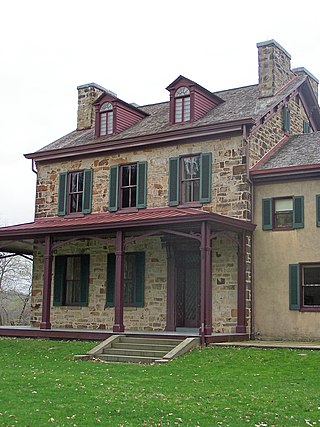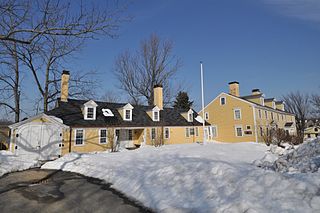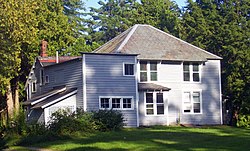
From the late 1870s to the 1920s, the Vanderbilt family employed some of the best Beaux-Arts architects and decorators in the United States to build an unequaled string of townhouses in New York City and palaces on the East Coast of the United States. Many of the Vanderbilt houses are now National Historic Landmarks. Some photographs of Vanderbilt residences in New York are included in the Photographic series of American Architecture by Albert Levy (1870s).

Edward Eggleston was an American historian and novelist.

George Cary Eggleston American author and brother of fellow author Edward Eggleston (1837–1902). Sons of Joseph Cary Eggleston and Mary Jane Craig. After the American Civil War he published a serialized account of his time as a Confederate soldier in The Atlantic Monthly. These serialized articles were later collected and expanded upon and published under the title "A Rebel's Recollections."

Friendship Hill was the home of early American politician and statesman Albert Gallatin (1761–1849). Gallatin was a U.S. Congressman, the longest-serving Secretary of the Treasury under two presidents, and ambassador to France and Great Britain. The house overlooks the Monongahela River near Point Marion, Pennsylvania, about 50 miles (80 km) south of Pittsburgh.

List of Registered Historic Places in Warren County, New York

Castle in the Clouds is a 16-room mansion and 5,294-acre (2,142 ha) mountaintop estate in Moultonborough, New Hampshire, opened seasonally to the public by the Castle Preservation Society. It overlooks Lake Winnipesaukee and the Ossipee Mountains from a rocky outcropping of Lee Mountain formerly known as "The Crow's Nest".

The Santanoni Preserve was once a private estate of approximately 13,000 acres (53 km²) in the Adirondack Mountains, and now is the property of the State of New York, at Newcomb, New York.

The Ladd-Gilman House, also known as Cincinnati Memorial Hall, is a historic house at 1 Governors Lane in Exeter, New Hampshire, United States. The home was built about 1721 by Nathaniel Ladd as one of the state's first brick houses, and was subsequently clapboarded three decades later. The home was purchased in 1747 by Daniel Gilman, a prominent Exeter merchant. It served as the state treasury during the American Revolutionary War when two members of the Gilman family, Col. Nicholas Gilman and his son John Taylor Gilman, later the state's governor, served as treasurers of the state. Also born in the house was Founding Father Nicholas Gilman, Jr., a signer of the United States Constitution and U.S. senator from New Hampshire.

The Thorstein Veblen Farmstead is a National Historic Landmark near Nerstrand in rural Rice County, Minnesota, United States. The property is nationally significant as the childhood home of Thorstein B. Veblen (1857-1929), an economist, social scientist, and critic of American culture probably best known for The Theory of the Leisure Class, published in 1899.

Woodlands, or the William Gilmore Simms Estate, is a historic plantation estate in Bamberg County, South Carolina. The property is nationally notable as the home for many years of author William Gilmore Simms (1806-1870), considered one of the leading literary voices of the antebellum Southern United States, and was designated a National Historic Landmark in 1971. The main house, built in part by Simms, contains mementos from his period.

College Hill, also known as George Walton House, Harper House, or Walton-Harper House, is a historic house at 2116 Wrightsboro Road in Augusta, Georgia. It was built in 1795, and was the home George Walton, a signer of the United States Declaration of Independence, from then until his death in 1804. It was declared a National Historic Landmark in 1971. It is a private residence, and is not open to the public.

Joel Chandler Harris House, also known as The Wren's Nest or Snap Bean Farm, is a Queen Anne style house at 1050 Ralph D. Abernathy Blvd., SW. in Atlanta, Georgia. Built in 1870, it was home to Joel Chandler Harris, editor of the Atlanta Constitution and author of the Uncle Remus Tales, from 1881 until his death in 1908.

The Hubert H. Bancroft Ranch House is a historic house museum at 9050 Memory Lane in Spring Valley, California. Built in 1856, it is the oldest Anglo-American building in the town. From 1885 until his death in 1918, it was home to Hubert Howe Bancroft, a pioneering historian of the western United States, Mexico, and Central America. Now managed by the local historical society as a museum, it was designated a National Historic Landmark in 1962 for its association with Bancroft, and was registered as a California Historical Landmark in 1958.

The Eggleston School is former school and current private residential structure located at the 10539 Nolan Road in rural Nester Township in southeastern Roscommon County, Michigan. It was designated as a Michigan Historic Site on February 29, 1996, and soon after added to the National Register of Historic Places on April 4, 1996. The school is particularly notable for the finely crafted fieldstone exterior, constructed of blocks with various shapes, sizes, and hues. It is the only property in Roscommon County listed on the National Register and one of only four county properties designated as a Michigan Historic Site — along with Gerrish Township Information Site, Pioneer House, and Turney House.

Lacawac is an historic, American estate that is located in Paupack Township and Salem Township, Wayne County, Pennsylvania.

The Heights, also known as the Thaddeus Chapman House is a historic country estate on Vermont Route 30 in Middlebury, Vermont. Developed in the 1870s and 1880s, the property is one of the finest estates of the period in the state. It was listed on the National Register of Historic Places in 1988.

Elizabeth Eggleston Seelye was an American writer and biographer. Her story "The A.O.I.B.R.", which appeared in Harper's Bazaar in 1889 with an illustration of a child reading, is cited by the Rockwell Centre for American Visual Studies as a surprisingly early illustration of a girl reading. Allegra Eggleston and Rosina Emmet Sherwood provided illustrations for Seelye's stories.

Allegra Eggleston was a 19th-century American artist from the U.S. state of Minnesota. She occupied herself as a woodcarver, portrait painter, and book illustrator. As an illustrator, she collaborated with her sister, Elizabeth Eggleston Seelye, and her father, Edward Eggleston, on a number of books including The story of Columbus (1892), The story of Washington, and The Graysons.






















